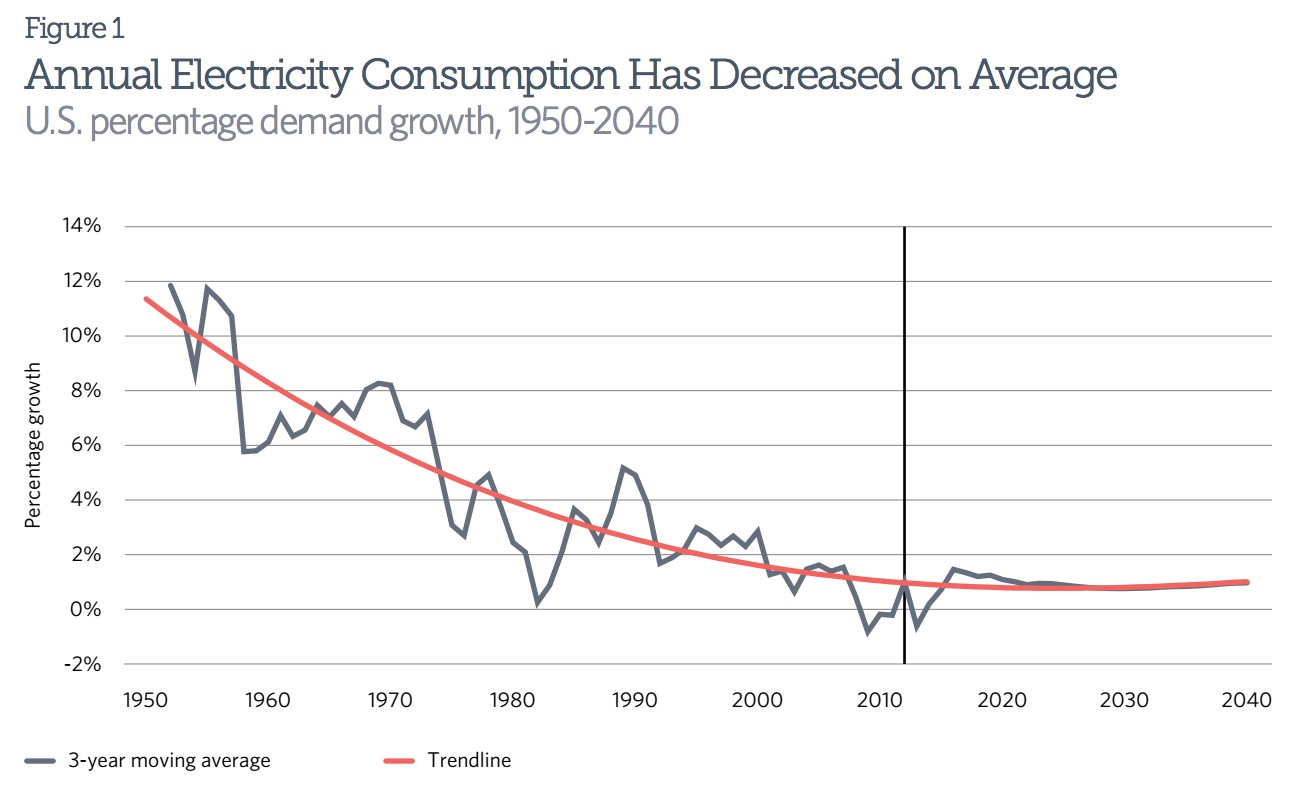THE PEW CHARITABLE TRUSTS
Overview
Electricity is illuminating, but its generation, transmission, and distribution have long been opaque. Today, however, the once static utility industry is becoming a dynamic and transformative opportunity for the nation’s economic, environmental, and energy future.
An array of technological, competitive, and market forces are changing how the U.S. generates power and the ways that Americans interact with the electric grid. A century-old centralized system is yielding to advanced, distributed-energy generation capabilities—in which power is produced at or near the place where it is consumed—that allow the industry to respond to new market opportunities and evolving consumer desires.
At the root of this evolution are years of flat electricity demand—the result of efficiency improvements; expanded, cost-effective, clean, and efficient generation options; changing expectations for energy infrastructure, such as an increased priority on reliability and security; and enhanced standards for controlling pollutants. These behavioral and economic shifts are driving the nation toward cheaper, cleaner energy sources and a decentralized fleet of power generators with growing competition. They also are putting pressure on businesses and policymakers to adapt to the evolving marketplace.
Distributed generation is not a passing fad, and new technologies pose significant challenges to long-standing business models. Utilities at the forefront of adoption and innovation are pursuing business and regulatory changes that will allow them to embrace and prosper in a new, less centralized future. At the other end of the spectrum, some utilities are trying to preserve the traditional model. And in the middle, the balance of the utility sector, also referred to in this analysis as the utility industry, is striving to understand and work with changing conditions. As the established industry struggles to modernize, more recent entrants to the sector—from solar energy and efficiency service companies to telecommunications and home security firms—are offering new goods and services in the electric marketplace.
Advancements that enable distributed generation will continue and probably gain momentum, but reluctant utility players could slow progress and delay realization of significant benefits such as a shift toward cleaner technologies. At the same time, the distributed electricity future must include and engage the utility sector; otherwise, the system could face reliability issues, fall short in capital investments, and produce higher power bills
Historically, the U.S. utility industry has done a tremendous job meeting the key societal challenge of providing reliable electricity to the entire country. Now, as recent polling shows, the public is demanding a cleaner, cheaper, and more decentralized energy future, and involving the utility industry in the growth of distributed generation should accelerate progress toward meeting those goals. For these reasons, the national interest will be best served if utilities take an active role in the energy revolution and ensure a healthy, innovative utility sector using clean, smart, and economically promising distributed energy resources.
This report examines the history of the changing electric grid to understand why and how it is evolving. It then looks at industrial energy efficiency technologies, sometimes referred to as cogeneration, and focuses on how this type of distributed generation—which includes combined heat and power (CHP) and waste heat to power (WHP)—can contribute to a cleaner, more secure, and more resilient electric grid.
These systems, which capture waste heat to produce power and/or heat or cool buildings, can help achieve national economic, environmental, and energy goals.
The report also identifies federal programs and policies that can help increase the deployment of these efficient technologies while shaping the nation’s energy future, including:
- Technical assistance. Several agencies are involved in efforts to close the information gap between prospective users of new technologies and project developers or manufacturers.
- Research. Studies and demonstration projects funded or conducted by government agencies can identify ways to overcome basic research challenges and commercialization barriers and help technologies emerge from labs and universities.
- Disaster response and mitigation. Targeted funding can help finance repair of energy infrastructure as well as modernization and resiliency efforts.
- Financial incentives. Tax credits, loans, and grant programs can help overcome upfront capital barriers that impede greater deployment of industrial energy-efficient technologies.
- Drivers of demand. Clear, consistent, and long-term goals can increase adoption and deployment of clean and efficient energy technologies.
- Interconnection and standby rate reform. Clear regulatory guidance to states can reduce regulatory barriers and cost impediments.
- Emissions reduction. Output-based emissions control programs can encourage greater adoption of industrial energy-efficient technologies.
The report concludes with an evaluation of the impact of key regulatory and legislative policies on the deployment of industrial energy efficiency technologies in order to help federal policymakers effectively encourage adoption of these systems. The Pew Charitable Trusts commissioned ICF International Inc. to model these policies and found that implementation of the U.S. Environmental Protection Agency’s Clean Power Plan and an improved federal investment tax credit could result in a 27 percent increase in adoption by 2030.
Download full version (PDF): Industrial Efficiency in the Changing Utility Landscape
About the Pew Charitable Trusts
www.pewtrusts.org
From its first day in 1948, Pew’s founders steeped the new institution with the entrepreneurial and optimistic spirit that characterized their lives. As the country and the world have evolved, we have remained dedicated to our founders’ emphasis on innovation. Today, Pew is a global research and public policy organization, still operated as a non-partisan, non-governmental organization dedicated to serving the public.
Tags: Clean Power Plan, Distributed Generation, Pew Charitable Trusts, Pew Trusts







 RSS Feed
RSS Feed